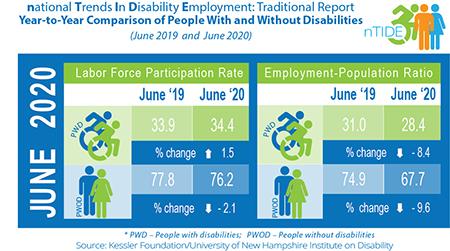Kessler Foundation and University of New Hampshire nTIDE Report — featuring the nonprofit National Organization on Disability, which guides business in best practices for diversifying workplaces with employees with disabilities

Credit: Kessler Foundation
East Hanover, NJ – July 2, 2020 – June job numbers marginally improved for Americans with and without disabilities, but the future remains uncertain as many states report recent spikes in COVID-19 cases, according to today’s National Trends in Disability Employment – Monthly Update (nTIDE), issued by Kessler Foundation and the University of New Hampshire’s Institute on Disability (UNH-IOD).
nTIDE COVID Update (month-to-month comparison)
In the Bureau of Labor Statistics (BLS) Jobs Report released Thursday, the employment-to-population ratio for working-age people with disabilities increased from 27.7 percent in May to 28.4 percent in June (up 2.5 percent or 0.7 percentage points). For working-age people without disabilities, the employment-to-population ratio also increased from 65.2 percent in May to 67.7 percent in June (up 3.8 percent or 2.5 percentage points). The employment-to-population ratio, a key indicator, reflects the percentage of people who are working relative to the total population (the number of people working divided by the number of people in the total population multiplied by 100).
“For the second consecutive month, we are seeing indications that people with and without disabilities returned to work as businesses opened up,” said John O’Neill, PhD, director of employment and disability research at Kessler Foundation. “However, keep in mind, these statistics are for the week of June 7th through 13th and thus do not reflect recent re-openings and closures of businesses as COVID-19 continues to affect the U.S,” he added.
The labor force participation rate for working-age people with disabilities increased from 34.2 percent in May to 34.4 percent in June (up 0.6 percent or 0.2 percentage points). For working-age people without disabilities, the labor force participation rate also increased from 74.8 percent in May to 76.2 percent in June (up 1.9 percent or 1.4 percentage points). The labor force participation rate is the percentage of the population that is (a) working, (b) not working and on temporary layoff, or (c) not working and actively looking for work.
“While these numbers are positive, there are continuing concerns that the longer closures last, the more workers will lose their jobs permanently after being on furlough, and will stop looking for work and thus exit the labor force,” explained economist Andrew Houtenville, PhD, research director of the University of New Hampshire’s Institute on Disability. “With the recent surge in identified COVID-19 cases, we will need to continue to monitor the employment situation of people with disabilities.”
nTIDE July COVID Update – Friday, July 17 at 12:00 pm Eastern
Stay tuned for more about the employment of people with disabilities as we follow the impact of COVID-19 and look at the numbers in more detail.
Traditional nTIDE Numbers (comparison to the same time last year)
The employment-to-population ratio for working-age people with disabilities decreased from 31.0 percent in June 2019 to 28.4 percent in June 2020 (down 8.4 percent or 2.6 percentage points). For working-age people without disabilities, the employment-to-population ratio also decreased from 74.9 percent in June 2019 to 67.7 percent in June 2020 (down 9.6 percent or 7.2 percentage points).
The labor force participation rate for working-age people with disabilities increased from 33.9 percent in June 2019 to 34.4 percent in June 2020 (up 1.5 percent or 0.5 percentage points). For working-age people without disabilities, the labor force participation rate decreased from 77.8 percent in June 2019 to 76.2 percent in June 2020 (down 2.1 percent or 1.6 percentage points).
For reference, in June 2020, among workers ages 16-64, there were 4,152,000 workers with disabilities, which is 3.1 percent of the total 133,634,000 workers in the U.S.
Beyond the Numbers
The abrupt onset of the COVID economy has stressed every aspect of employment for people with disabilities – individuals striving to work, caregivers striving to provide support, businesses striving to maintain staff, and service providers striving to maintain their connections with clients and employers. To maximize the inclusion of workers with disabilities in the new economy, organizations that support disability employment are monitoring the changing landscape and resetting their priorities.
The private nonprofit National Organization on Disability (NOD) provides expert guidance to businesses seeking to meet their human resource needs with talented jobseekers with disabilities. As the COVID-19 pandemic spread across the U.S., NOD’s Disability Employment Professional Services adapted to meet employers’ needs to cope with new challenges to their inclusive workforces. Among the top priorities – the need to expand digital accessibility to accommodate remote work and collaboration. Expanding access through communications technology may benefit businesses longer term, creating new opportunities and fostering greater diversity in the workplace, according to NOD’s Corporate Leadership Council. Employers also cited mental health issues and caregiver stress, both exacerbated by pandemic restrictions, among the pressing challenges they need to address with their workers with disabilities.
Through its COVID-19 Emergency grant program, Kessler Foundation also identified technology and services for remote access as a top priority among recipients of their national and community employment grants. Many grantees faced overwhelming challenges to continuing their job programs. “As we mark the 30th anniversary of the Americans with Disabilities Act, the pandemic is uncovering new disparities that hinder equal access for people with disabilities,” said Elaine E. Katz, MS, CCC-SLP, senior vice president of the Center for Communications and Grantmaking at Kessler Foundation. “Focusing on technology that facilitates remote access will help people with disabilities compete effectively for jobs in the COVID era economy and connect with health care and community services,” she added. “To continue to move forward, however, means prioritizing the needs of individuals with anxiety and depression, and their caregivers who provide essential support.”
Ask Questions about Disability and Employment
Each nTIDE report is followed by a noon ET Lunch & Learn webinar. These live broadcasts, hosted via Zoom Webinar, offers attendees Q&A on the latest nTIDE findings, provide news and updates from the field, as well as invited panelists to discuss current disability-related findings and events. On July 2, at 12:00 pm ET. Charles Catherine, special assistant to the president of the National Organization on Disability, joins Dr. Houtenville, Dr. O’Neill, and Denise Rozell, Policy Strategist at AUCD. Join live or watch the recordings at: ResearchonDisability.org/nTIDE.
NOTE: The statistics in the nTIDE are based on Bureau of Labor Statistics numbers but are not identical. They are customized by UNH to combine the statistics for men and women of working age (16 to 64). nTIDE is funded, in part, by grants from the National Institute on Disability, Independent Living and Rehabilitation Research (NIDILRR) (90RT5037) and Kessler Foundation.
###
About Kessler Foundation
Kessler Foundation, a major nonprofit organization in the field of disability, is a global leader in rehabilitation research that seeks to improve cognition, mobility, and long-term outcomes — including employment — for people with neurological disabilities caused by diseases and injuries of the brain and spinal cord. Kessler Foundation leads the nation in funding innovative programs that expand opportunities for employment for people with disabilities. For more information, visit KesslerFoundation.org.
About the Institute on Disability at the University of New Hampshire
The Institute on Disability (IOD) at the University of New Hampshire (UNH) was established in 1987 to provide a coherent university-based focus for the improvement of knowledge, policies, and practices related to the lives of persons with disabilities and their families. For information on the NIDILRR-funded Employment Policy and Measurement Rehabilitation Research and Training Center, visit ResearchonDisability.org.
For more information, or to interview an expert, contact:
Carolann Murphy, 973.324.8382, [email protected].
Media Contact
Carolann Murphy, PA
[email protected]




